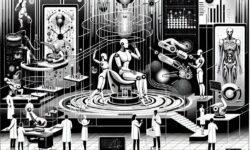
Why Protein Design Is Suddenly Everywhere
Proteins are the workhorses of life. They fold into shapes that cut plastic, sense toxins, build scaffolds for vaccines, and move atoms like Lego pieces. For decades, tuning a protein to do something new required slow lab work and a lot of luck. Today, a new stack—generative models, cheap DNA printing, and compact lab robots—lets teams design proteins on a laptop and test them in days.
This field is called generative biology. It borrows ideas from image and language models but learns from amino acid sequences and 3D structures. Instead of asking a model to draw a cat, you ask it to produce a sequence that folds into a shape that binds a target, catalyzes a reaction, or self-assembles into a useful material.
It’s not gene editing. Tools like CRISPR change DNA that already exists. Generative biology writes new sequences from scratch. It aims to create proteins nature never tried, with functions we need now: enzymes that turn waste into feedstock, biosensors for water safety, and binders that neutralize pathogens without refrigeration.
What “Generative Biology” Actually Means
The short version
Generative biology uses machine learning to propose new biological designs and guides rapid experiments that test them. The loop is simple:
- Predict a promising protein sequence on a computer.
- Print the DNA that encodes it.
- Produce the protein in cells or cell-free systems.
- Probe whether it does the job you want.
- Patch the design based on results, and repeat.
What changed is speed. Structure prediction models like AlphaFold made a once-hard problem easy enough for non-specialists. DNA synthesis has become fast and affordable. Modular lab robots pipette, incubate, read fluorescence, and log everything. The cycle that took months now fits into a week at many labs, and sometimes a long weekend.
Why it’s happening now
- Data overflow: We have millions of known protein sequences and hundreds of thousands of structures. Models can learn from both and generalize.
- Structure prediction: Given a sequence, tools now predict plausible 3D shapes. That gives instant feedback during design.
- Cheaper synthesis: Printed DNA and assembly kits let you try dozens to thousands of candidates without breaking the bank.
- Lab automation: Open, low-cost robots and standardized assays cut hands-on effort and variability.
The result: biology that behaves more like engineering. You don’t just discover. You specify, build, and iterate.
The New Protein Design Toolchain
Step 1: Gather the right starting points
Designs start from context. What reaction do you want? Which surface or molecule should the protein stick to? Teams pull from public databases of structures and sequences. They also collect kinetic data, binding affinities, and known motifs. A good brief to a model sounds like a clear product spec—inputs, outputs, and constraints.
Step 2: Generate candidates
Generative models produce new sequences that fit your spec. Two families dominate:
- Language models over sequences “read” vast sets of amino acid strings and learn patterns that correlate with functional families. You can sample new sequences that look “protein-like” and steer them with prompts or conditioning.
- Diffusion models over structures begin with noise and sculpt a 3D protein shape that matches a target binding site or geometry. They then back out sequences likely to fold into those shapes.
Many teams combine both. They generate a 3D concept, translate it to a sequence, and then refine that sequence using language-model scoring or evolutionary constraints.
Step 3: Screen in silico
Not every sample is worth a lab test. You filter candidates using fast predictors:
- Foldability: Does the sequence likely collapse into a stable shape?
- Binding: Does the surface complement the target? Quick docking tools give a first pass.
- Stability: Will it stay folded at a useful temperature and pH? Models estimate stability shifts from mutations.
- Solubility and expression: Will it behave in your production host? Sequence-level predictors flag likely issues.
For top candidates, teams sometimes run short molecular dynamics to check that a pose remains stable. They keep their simulations modest—seconds or minutes of compute, not days—because the real learning happens when you measure in a tube.
Step 4: Build and test fast
“AI-designed” sounds abstract until you hold a tube with the protein you asked for. The build-and-test step is the moment of truth:
- DNA synthesis: Order genes encoding your design with codons tuned for your host (often E. coli or yeast).
- Expression: Produce the protein inside cells or in cell-free mixes that work on a benchtop.
- Assay: Measure activity based on a simple readout—fluorescence, absorbance, binding tags, or product formation.
- Automation: Small robots pipette liquids, clone plasmids, and run 96- or 384-well assays while logging metadata.
The winners move forward. The near-misses teach the model. And the rest get archived as negative examples, which are just as helpful later.
Step 5: Learn and iterate
Design improves when you close the loop. Teams feed assay results back into the model and select new variants. The math varies—Bayesian optimization, evolutionary strategies, or reinforcement—but the goal is the same: find a peak in a rugged landscape with as few wet experiments as possible.
A typical stack
- Data: Public sequence and structure repositories, plus internal assay records.
- Models: Sequence LMs, diffusion for structure, stability predictors, docking tools.
- Build: DNA synthesis providers, cloning kits, expression hosts, cell-free systems.
- Test: Plate readers, chromatography, mass spectrometry, automated liquid handlers.
- Ops: Version control, lab notebooks with structured metadata, cloud storage.
Real Projects You Can Picture
Plastic-eating enzymes that work at room temperature
Scientists have engineered enzymes that chop up PET plastic into its building blocks. Recent variants work quickly and at lower temperatures, which matters for real recycling. The design didn’t rely on one lucky mutation; it mixed structural insight, machine learning, and lots of lab testing. The end result: plastic bottles broken down in hours rather than months, with the pieces ready for clean re-polymerization.
Protein cages as vaccine scaffolds
Vaccines often present viral pieces to the immune system. Self-assembling protein cages do this neatly. Designers now build cages from scratch that display antigens at precise distances and angles, which can steer a stronger response. These are bottom-up nanostructures with parts the model invented, not copied. They are stable, fridge-friendly, and easy to manufacture in microbes.
Biosensors that glow when water is safe
Cell-free biosensors package the translation machinery of a cell into a powder that wakes up when you add water. Add a designed protein that binds a target contaminant—say a pesticide—and you can build test strips that turn a color or emit light. Because the system is cell-free, the safety and regulatory path is simpler. The entire sensor recipe, from protein design to paper-based readout, is programmable.
De novo binders that neutralize targets
Designers have created proteins that latch onto specific sites on viral proteins or enzymes. These de novo binders are small, stable, and don’t require the complex sugar decorations antibodies need. They can be nebulized, stored warm, or embedded in materials. The trick is a model that sculpts a pocket-perfect surface, then a quick round of lab selection to dial in the kinetics.
How Teams Decide a Design “Works”
Protein design succeeds when function is reliable in context. Labs track a handful of practical metrics:
- Activity: For enzymes, kcat/Km under realistic conditions. For binders, affinity (KD) and on/off rates.
- Stability: Melting temperature (Tm), protease resistance, and shelf life in the intended formulation.
- Expression yield: mg per liter in the chosen host and purification steps required.
- Specificity: Off-target binding, cross-reactivity, and unintended reactions.
- Manufacturability: Solubility, aggregation risk, and cost per gram at scale.
Teams also test function in the real world. An enzyme may set records in a buffer but slow to a crawl in a detergent. A binder may grab a purified protein but ignore it on a crowded cell surface. Fast cycles with small, honest tests beat one heroic number on a poster.
From Demo to Product
Production choices
Most proteins are made by microbes in stainless steel tanks. E. coli often wins for speed and cost, yeast for secreted proteins, and filamentous fungi for industrial enzymes. Some very small proteins can be made by chemical synthesis, which allows tweaks like non-natural amino acids or precise conjugation. Early in a project, teams test hosts in parallel to avoid surprises later.
Formulation and delivery
An enzyme that sings in a lab may struggle in a product bottle. Formulators add stabilizers, tune pH, and pick excipients that keep function high. For biosensors, the trick is often lyophilization—freeze-drying the system so it stores for months and rehydrates quickly. For environmental tools, the device around the protein—paper, hydrogel, or a polymer matrix—matters as much as the sequence itself.
Regulatory path
- Industrial enzymes: Often treated as processing aids. You still need safety and environmental data.
- Diagnostics: Clear specs, calibration, and quality systems. Clinical diagnostics have stricter requirements than environmental tests.
- Therapeutics: Long path, with toxicology, immunogenicity, and manufacturing consistency all under scrutiny.
Design doesn’t shortcut regulation, but it helps you pick better leads earlier, which saves time and cost.
Safety by Design
Design power demands discipline. Responsible teams build safety into every layer:
- Sequence screening: DNA orders are screened against restricted lists by providers who follow industry guidelines.
- Containment: Work is done at appropriate biosafety levels with trained staff.
- Scope control: Projects focus on targets with clear public benefit, like waste processing, sensing, or vetted therapeutics.
- Transparency: Methods and risk assessments are documented. If a design could be misused, access and sharing are controlled.
As the tools get easier, norms matter more. Many community labs, universities, and companies share checklists and training so newcomers learn good habits from day one.
The New Roles in Generative Biology
Who builds this future
- Sequence modelers: Train and steer generative models, maintain datasets, and create scoring functions tied to real assays.
- Protein engineers: Convert model ideas into expression-ready constructs and design practical assays.
- Automation engineers: Script robots, manage labware, and ensure data capture is clean and searchable.
- Molecular product managers: Define the product spec in biochemical terms and align lab work with end-user needs.
- Biofoundry ops: Run the build-test-learn loop as a service for multiple teams.
How to get started
You do not need a giant budget to learn the basics:
- Explore public structure and sequence databases and try fold predictions for a protein you care about.
- Play with binder design notebooks on a cloud GPU to learn the flow without handling any biology.
- Join a community lab to learn safety, pipetting, and simple assays under guidance.
- Read papers that connect model claims to hard wet-lab numbers.
What’s Next: Short Loops and Smarter Specs
Hours, not weeks
Many groups aim to compress the full loop—design, synthesize, express, assay—into a day. Cell-free expression helps because it skips cell growth. DNA synthesis times continue to fall. Some labs already run overnight loops for small designs. The big shift is not magic; it’s plumbing: better inventory tracking, unified formats, and robots that talk to the notebook.
Better objectives, richer data
Models are getting better at predicting more than shape. They learn from function logs—enzymatic rates, expression yields, and shelf-life. That means you can ask for “a PET-degrading enzyme with 10x activity at pH 9, stable for 30 days at 25°C,” not just “a protein that looks like this.” Data that used to sit in PDFs now trains the next round.
Protein-plus systems
Many useful tools are not a single protein. They are systems: a scaffold that positions multiple enzymes, a sensor coupled to a reporter, or a composite that houses a protein in a protective matrix. Generative biology will increasingly co-design these parts—sequence, material, and device—so they work together on day one.
What You Can Try Today (Safely)
- Browse structures: Look up a protein you’ve heard of and view its predicted structure in a browser.
- Run a binder demo: Use a public notebook to design a toy binder to a small target and inspect the predicted interface.
- Compare sequences: Use a language model scoring tool to see how “natural” a designed sequence looks.
- Learn the assays: Watch videos on plate readers and simple enzyme tests. Understanding the readouts is half the battle.
If you want hands-on practice, join a supervised community lab or academic course. Do not order DNA or express proteins without training and an approved setting.
Why This Matters
Proteins are tiny machines. Being able to design them expands what people can build without heavy industry. Rivers get real-time sensors for contaminants. Packaging enzymes reduce plastic to building blocks. Low-cost binders enable fast tests during outbreaks. These are not science-fiction milestones. Many already exist as prototypes and pilot products. What was once rare is now becoming routine.
Generative biology is not a single breakthrough. It’s a toolkit that turns biology into a design discipline. As the loop tightens, the distance from idea to useful molecule shrinks. That opens the door for small teams with sharp questions and good lab practice to solve problems that used to require a decade and a giant budget.
Summary:
- Generative biology uses AI to design new proteins and closes the loop with fast DNA synthesis and lab automation.
- Modern models work on sequences and structures, then filter candidates with quick predictors before wet-lab tests.
- Real projects include plastic-degrading enzymes, vaccine scaffolds, cell-free biosensors, and de novo binders.
- Success is measured by activity, stability, specificity, yield, and manufacturability in real-world conditions.
- Scaling to products requires smart production hosts, formulation, and clear regulatory paths.
- Safety practices—sequence screening, containment, and transparency—are essential as tools get easier.
- New roles blend modeling, protein engineering, and automation; you can learn basics with open tools and community labs.
- Near-term progress will shorten design cycles and enable richer, function-first specifications.
External References:
- AlphaFold overview by DeepMind
- AlphaFold Protein Structure Database
- ESM Metagenomic Atlas and ESMFold
- RFdiffusion: generative protein design (GitHub)
- FAST-PETase plastic-degrading enzyme (UT Austin)
- Open-source lab automation (Opentrons)
- Nanopore sequencing and analysis tools (Oxford Nanopore)
- International Gene Synthesis Consortium screening guidelines





